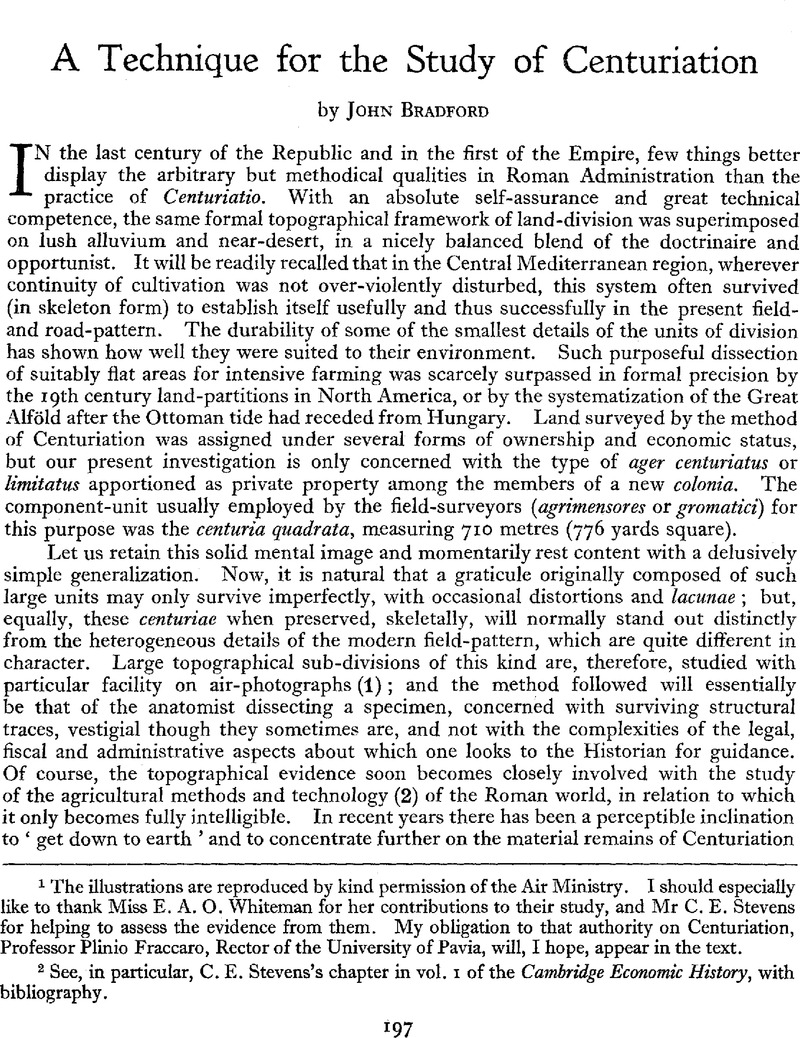Article contents
A Technique for the Study of Centuriation
Published online by Cambridge University Press: 26 May 2015
Abstract

- Type
- Research Article
- Information
- Copyright
- Copyright © Antiquity Publications Ltd 1947
References
1 The illustrations are reproduced by kind permission of the Air Ministry. I should especially like to thank Miss E. A. O. Whiteman for her contributions to their study, and Mr C. E. Stevens for helping to assess the evidence from them. My obligation to that authority on Centuriation, Professor Plinio Fraccaro, Rector of the University of Pavia, will, I hope, appear in the text.
2 See, in particular, C. E. Stevens’s chapter in vol. I of the Cambridge Economic History, with bibliography.
3 This has been done by Prof. Fraccaro with notable effect and a skill that has robbed the subject of its terrors, in the following:—‘La centuriazione romana dell'agro Pisano’, in Studi Etruschi, XIII, 1939; ‘Centuriazione romana dell’agro Ticinense’, in Atti e Memorie del Quarto Corigresso Storico Lombardo, 1940 ; ‘Intorno ai confini e alla centuriazione degli agri di Patavium e di Acelum’, in Studi di Anticlzita Classica offerti a Emunuele Ciaceri, 1940 ; ‘ La colonia romana di Eproredia (Tvrea) e la sua centuriazione’, in Annali dei Lavori Pubblici, 1941 ; see also his article ‘Agrimensura’ in Enciclopedia Italiana.
4 Blume, Lachman, Rudorff, Die schriften dw römischer Feldmesser, (vol. I, texts; vol. 11, commentaries), 1848–52. There is a later edition, by Thulin, of the texts and diagrams, Corpus Agrimensorum Romanorurn, Leipsig, 1913. The professional opinion of the modern surveyor can be most enlightening, and De Caterini’s study of the subject is valuable, i.e. ' Gromatici Veteres:—I teclinici erariali dell ‘antica Roma’, in Revista del Catasto e dei Servizi Technici Erariali, 1935, pp. 261–358.
5 During the war I have known air-photographs to be torn up, because they did not agree with the map!
6 ‘I progressi della cartografia ebbero sotto questo aspetto un’ importanza paragonabile a quella che oggi ha assunto per le indagini di topografia storica l’esplorazione dall’aéroplano, ma non furono sufficientemente sfruttati’, Studi di Antichita Classica offerti a Emanuele Ciaceri, 1940.
7 Fabricius in his article on Limitatio in Pauly-Wissowa, Real-Enciclopädie, summarized the copious literature up to 1927; see also ibid (1894), Ager, Agrimensores. Later references will be found in Prof. Fraccaro’s works, as cited above.
8 Ancient tradition stated that the unit of larid (heredium) originally distributed to the Romans by Romulus equalled z jugera in area. Now, a centuria measuring 2400 Roman feet square (776 by 776 yards) contained 200 jugera, or the equivalent of 100 heredia; whence the name derives. The jugerum was the area that supposedly could be ploughed by a man with two oxen in one day. The size of a centuria was also expressed in terms of the actus, which was 120 Roman feet long (116.05 English feet). Two square actus (120 by 240 R. ft.) equalled I jugerum. The centuria that was 2400 R. ft. square, thus also measured ZG actus along each side, or 400 square actus in area. So, in practice, when working with air-photographs and maps on the structure of centuriae and their internal sub-divisions, one is always on the watch for linear measurements that roughly form multiples of 116 E. ft.
9 Their minimum-maximum width, carefully measured from the air photographs ranges from 1710 to 1790 E. ft., and 1740 E. ft. (very close to the average) is precisely 15 actus.
10 See Fraccaro in Studi di Antichita Classics offerti a Ciaceri. The 21 by 21 actus units of the adjacent system South of Asolo are still visibly divided into 3 strips of 7-actus width.
11 The Roman surveyors describe various specimen allotments, and a four-fold division by ‘Triumviral’ units is known to have existed; see Pauly-Wissowa, ReaZ-Encicl., ‘Limitatio’.
12 See Bonner Jahrbücher, 1911, Taf. V.
13 S. Casson, Macedonia, Thrace and Illyria, p. 317.
14 See M. P. Charlesworth, in Camb. Anc. Hist., vol. X, 88; and ibid, p. 903 and 939 (for bibliographies).
15 15 On fig. I between A (Zadarski Kanal) and B (Amika Point) can be seen, on the coast, a few noticeably straight roads and field-boundaries. They are not part of the original 200-jugera centuriation, appear composite in date, and are shown mainly in order to eliminate them.
- 5
- Cited by




